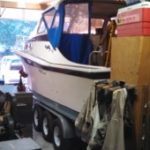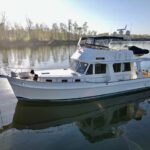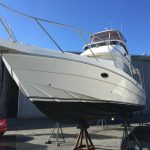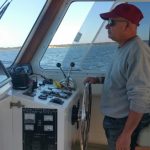Cummins Marine Diesel Repower Specialists › Forums › Cummins Marine Engines › Aftercooler pressure tester
- This topic has 24 replies, 11 voices, and was last updated 2 years ago by
 Matt Lyman.
Matt Lyman.
-
CreatorTopic
-
November 9, 2019 at 12:39 pm #81183

worldcatlemonParticipantVessel Name: Adjusted Priorities
Engines: QSB 425 Cummins
Location: Pacific Northwest
Country: United States
So after cleaning the aftercooler core I wanted to pressure test it for leaks before assembling the aftercooler. I saw a picture of the way Seaboard tests them but I wanted something I could hook up quickly since I have 2 aftercoolers to test.
I thought I would share my cheap and easy design . ABS 4″ pipe with a 5″x4″ reducer, end caps, with one end tapped with a female air fitting and valve so I can regulate the air pressure.
It took about 20 minutes to build but I can look for leaks before going through the process of reassembly.
1 user thanked author for this post.
-
CreatorTopic
-
AuthorReplies
-
February 21, 2022 at 12:16 pm #127213

Matt LymanParticipantI tested to 25 PSI with air, per a lot of recommendations on this site.
February 21, 2022 at 9:56 am #127203
Rob SchepisForum ModeratorVessel Name: Tenacious
Engines: 6BTA 5.9 330's - "Seaboard Style"
Location: Long Island, NY
Country: USA
I see no reason to go beyond 25psi.
February 21, 2022 at 2:08 am #127184
Jim FosterParticipantWhat psi did you pressurize to? Ive seen someone do 14 or so psi, but then another using 36 psi? What should be correct?
February 18, 2022 at 12:02 pm #127108
Matt LymanParticipantI didn’t see any 5 PSI when I bought them from the box at HD, so I didn’t know till now! I did stand clear though. They worked great for me, and I’ll use them again. Next time I’ll take pics.
February 18, 2022 at 6:17 am #127093
Gene FullerParticipantVessel Name: Yorkshire Rose
Engines: QSB5.9 380
Location: Punta Gorda, Florida
Country: USA
Why?
Perhaps because they are listed for 5 psi max and are clearly labeled “Stand Clear”.
I have tried various low-pressure plumbing gadgets. They either blew off or looked pretty scary when they bulged.
February 17, 2022 at 7:48 pm #127072
chrism6784ParticipantActually that seems a lot easier and cheaper. Almost like why didn’t anyone think of it sooner? I like have those actually and can’t believe I didn’t think to use them
February 16, 2022 at 9:28 pm #127015
Matt LymanParticipantIt didn’t for me. The ends blew off. What did work REALLY well, was to put these on the raw water intake and outtake holes on the housing caps:
https://www.homedepot.com/p/Oatey-Gripper-3-in-Plastic-Mechanical-Test-Plug-33402/100168770
I then used a hand pump with a pressure gauge and attached it to one of the zinc plugs and pumped it up to 25 PSI for an hour.
This was all done once assembled of course, but what was nice was I could keep the housing in place, which is a real pain to remove on a QSC.
Sorry, I don’t have any pics.
February 16, 2022 at 6:43 pm #127009
chrism6784ParticipantSo did this system work??? I’m going to try building this tomorrow just curious if anyone found out if it worked
November 16, 2019 at 9:43 am #81997And add a potentially leaking test rig apparatus to the mix…
So true. When I was assembling my test unit for the fully assembled aftercooler, it took quite a few tries for me to get the test equipment to seal. The aftercooler was not leaking. Submerging the entire aftercooler while under air pressure made finding the leak sources easier. Thanks for that advice Rob!
I did not test the core separately, but next time I will.
TomNovember 16, 2019 at 8:10 am #81996
Rob SchepisForum ModeratorVessel Name: Tenacious
Engines: 6BTA 5.9 330's - "Seaboard Style"
Location: Long Island, NY
Country: USA
And add a potentially leaking test rig apparatus to the mix…
November 16, 2019 at 8:05 am #81995
Tony AthensModeratorVessel Name: Local Banks
Engines: QSB 6.7 550 HP
Location: Oxnard, CA
Country: USA
The point Rob makes is right on .. But without testing the core separate, you really are not sure what is leaking–the core or the o-rings.
November 16, 2019 at 5:28 am #81988
Rob SchepisForum ModeratorVessel Name: Tenacious
Engines: 6BTA 5.9 330's - "Seaboard Style"
Location: Long Island, NY
Country: USA
and our track record on this is 100% on an easy 1000 ++ aftercooler services. over the past 28+ years.
There in lies the difference … average boater is going to do 1 (or 2) aftercooler services every 3 -5 years. Although that track record proves the assembled unit to be reliable if all is right I do think that the DIY boater should not skip the assembled unit pressure test. Too easy to do and takes out the possibility of an o-ring issue, corroded sealing surface, etc….
November 15, 2019 at 6:52 pm #81967
Tony AthensModeratorVessel Name: Local Banks
Engines: QSB 6.7 550 HP
Location: Oxnard, CA
Country: USA
Core testing by itself is by far and away the most important part of aftercooler servicing, if something with the core is suspect…………
We just about never test the assembled unit as if you know what you are doing on the final assembly side, understand what to look for on the housing sealing surfaces ( and service them as needed) , IMO it is not necessary, and our track record on this is 100% on an easy 1000 ++ aftercooler services. over the past 28+ years.
Plenty of pics on this site as to what matters on the o-ring sealing surfaces..
Tony
November 15, 2019 at 3:55 pm #81942
Stephen OliverParticipantVessel Name: Ascella
Engines: 2x Cummins 330hp Diamond
Location: Perth, Australia
Country: Australia
Seems like twice the work to me, but, if the assembly leaks and you’ve already tested the core itself is good then you know it’s the assembly, so it could pay off… The assembly is simple enough so if there is a leak it’s usually the core or the pressure rig itself.
Unless like me Rob, you have a porous housing that leaks… Mine was dumping quite a bit of pressure and it wasnt very obvious as it was porosity right through but masked by the paint. Once found I ground it out and used in weld on Tony’s instruction. Obviously a rare case but at least I would have had confidence in my core if tested this way.. there are a dozen ways to approach this though and all are good..?
Steve
November 11, 2019 at 8:17 pm #81509
Rob SchepisForum ModeratorVessel Name: Tenacious
Engines: 6BTA 5.9 330's - "Seaboard Style"
Location: Long Island, NY
Country: USA
Seems like twice the work to me, but, if the assembly leaks and you’ve already tested the core itself is good then you know it’s the assembly, so it could pay off… The assembly is simple enough so if there is a leak it’s usually the core or the pressure rig itself.
November 10, 2019 at 8:57 pm #81332
worldcatlemonParticipantVessel Name: Adjusted Priorities
Engines: QSB 425 Cummins
Location: Pacific Northwest
Country: United States
Still working out the kinks in my pressure tester….Lol
I will test the entire unit once I know the core doesn’t leak. By testing the core before installation if it has any pinholes i won’t waste grease and have to clean grease up. All my other sealing surfaces are smooth and new orings, so doubtful it will leak.
November 10, 2019 at 4:38 pm #81307
Fireisland1ParticipantVessel Name: Riverwind
Engines: cummins QSB 380
Location: long island n.y.
Country: usa
I like that a lot but it only tests the core. What about the assembly?
November 10, 2019 at 8:18 am #81254Possibly send (to his email address) Tony the article in a “Word” format so it can be edited as needed (for formatting etc.)?
November 9, 2019 at 9:40 pm #81235
worldcatlemonParticipantVessel Name: Adjusted Priorities
Engines: QSB 425 Cummins
Location: Pacific Northwest
Country: United States
Tony, I enjoy working on stuff and would write an article. I’m just not real sure how to do it in the format you mentioned.
November 9, 2019 at 5:47 pm #81209
Tony AthensModeratorVessel Name: Local Banks
Engines: QSB 6.7 550 HP
Location: Oxnard, CA
Country: USA
Aftercooler core pressure tester tool
Consider putting this all together as a “How to Project” in a article form and Ill share your ingenuity in the my a article section..
Stuff like this goes a long ways in this community and is very applicable to other engines besides Cummins.
It won’t make you famous should you decide to run for president some day, but you will end up with a few extra Seaboard T-shirts..
Tony
-
AuthorReplies
You must be logged in to reply to this topic.
